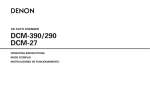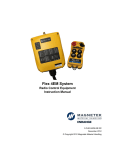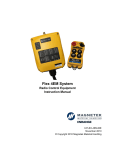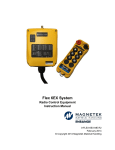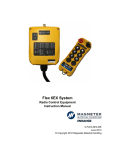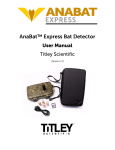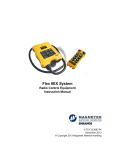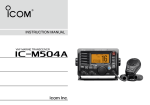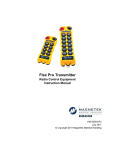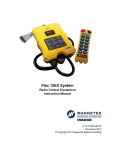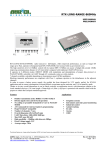Download FLEX2JX - Advanced Radiotech Corporation
Transcript
FLEX2JX Instruction Manual Service Information Your New Radio System Thank you for your purchase of ARC Flex 2JX radio remote control system. Without a doubt, our Flex 2JX system is the ultimate solution for providing precise, undeterred, and safe control of your material. If your product ever needs modification or service, please contact our representative in your country or at the following location: World Headquarter: Advanced Radiotech Corporation 288-1, Hsin Ya Road, Chien Chen District Kaohsiung, Taiwan Telephone: +886 7 812 8112 Fax Number: +886 7 812 8119 Website: www.advanced-radiotech.com E-mails: [email protected] [email protected] All rights reserved. This notice applies to all copyrighted materials included with this product, including, but not limited to, this manual and software embodied within the product. This manual is intended for the sole use of the person(s) to whom it was provided, and any unauthorized distribution of the manual or dispersal of its contents is strictly forbidden. This manual may not be reproduced in whole or in part by any means whatsoever without the expressed written permission of ARC. Flex 2JX System Instruction Manual June 2015 Page 1 of 60 PRODUCT MANUAL SAFETY INFORMATION Advanced Radiotech Corporation (ARC) offers a broad range of radio remote control product for material handling applications. This manual has been prepared by ARC to provide information and recommendations for the installation, use, operation and service of ARC’s material handling products and systems (ARC Products). Anyone who uses, operates, maintains, services, installs or owns ARC Products should know, understand, and follow the instructions and safety recommendations in this manual for ARC Products. The recommendations in this manual do not take precedence over any of the following requirements relating to cranes, hoists lifting devices or other material handling equipment which use or include ARC Products: Instructions, manuals, and safety warnings of the manufacturers of the equipment where the radio system is used. Plant safety rules and procedures of the employers and the owners of facilities where the ARC Products are being used. Safety standards and practices for the industries in which ARC Products are used. This manual does not include or address the specific instructions and safety warnings of these manufacturers or any of the other requirements listed above. It is the responsibility of the owners, users and operators of the ARC Products to know, understand and follow all of these requirements. It is the responsibility of the employer to make its employees aware of all of the above listed requirements and to make certain that all operators are properly trained. No one should use ARC Products prior to becoming familiar with and being trained in these requirements and the instructions and safety recommendations in this manual. WARRANTY INFORMATION For information on ARC’s product warranties, please contact ARC representative nearest to you or visit www.advanced-radiotech.com. Flex 2JX System Instruction Manual June 2015 Page 2 of 60 Table of Contents Page 1. 2. 3. 4. 5 Introduction Radio Controlled Safety General System Information 6 3.1 Transmitter 11 3.2 Receiver 3.2.1 External Illustration 12 3.2.2 Internal Illustration 13 Function Settings 4.1 Transmitter 4.2 4.1.1 Programming Procedure 14 4.1.2 Transmitter Channel 15 4.1.3 Transmitter Type 15 4.1.4 Transmitter Inactivity Timer 16 4.1.5 Transmitter Output Power 16 4.1.6 Transmitter Infrared Mode 17 4.1.7 Transmitter Infrared ID 17 4.1.8 Transmitter Infrared START Function 18 4.1.9 Transmitter Tilt Function 18 4.1.10 Joystick Configuration 19 4.1.11 SW1 Button Function 20 4.1.12 SW2 Button Function 20 4.1.13 SW3 Button Function 21 4.1.14 SW4 Button Function 21 4.1.15 SW5 Button Function 22 4.1.16 SW6 Button Function 22 4.1.17 SW7 Button Function 23 4.1.18 Save Function 23 4.1.19 I-Chip Installation 23 Receiver Unit 4.2.1 Programming Procedure 24 4.2.2 I-Chip Programming 25 4.2.3 Receiver Channel 25 4.2.4 Receiver Channel Scanning 26 4.2.5 Receiver Type 27 4.2.6 Main Relay Function 27 4.2.7 Function Relay #1 28 4.2.8 Function Relay #2 29 4.2.9 Output Relay Configurations 30 4.2.10 Joystick LX Acceleration and Deceleration Delay 32 Flex 2JX System Instruction Manual June 2015 Page 3 of 60 5. 6. 8. 9. 10. 11. 32 4.2.12 Joystick RX Acceleration and Deceleration Delay 33 4.2.13 Joystick RY Acceleration and Deceleration Delay 33 4.2.14 Analog Outputs (Voltage, Current and PFM) 34 4.2.15 SW1+SW2 Output Relays Function 36 4.2.16 SW1 Output Relay Function 37 4.2.17 SW2 Output Relay Function 38 4.2.18 SW3 Output Relay Function 39 4.2.19 SW4+SW5 Output Relays Function 40 4.2.20 SW4 Output Relay Function 41 4.2.21 SW5 Output Relay Function 42 4.2.22 SW6+SW7 Output Relays Function 43 4.2.23 SW6 Output Relay Function 44 4.2.24 SW7 Output Relay Function 45 4.2.25 Save Function 46 4.2.26 Voltage Settings 46 System Channels Table Receiver Installation 6.1 7. 4.2.11 Joystick LY Acceleration and Deceleration Delay 47 Output Relay Contact Diagram 6.1.1 Digital Outputs 48 6.1.2 Analog Outputs 49 6.2 Pre-Installation Precautions 50 6.3 Step-By-Step Installation 50 6.4 System Testing 51 Operating Procedure 7.1 General Operating Procedure 52 7.2 Pitch & Catch Operating Procedure 53 7.3 Automatic Channel Scanning Operating Procedure 54 7.4 Battery Changing Instruction 54 Status & Warnings 8.1 Transmitter 8.2 Receiver 55 8.2.1 LED STATUS Indications 56 8.2.2 LED SQ Indications 56 8.2.3 LED POWER Indications 56 8.2.4 LED COM Indications 56 8.2.5 LCD Indications 57 Trouble Shooting Tips System Specifications EU Declaration of Conformity 58 59 60 Flex 2JX System Instruction Manual June 2015 Page 4 of 60 1. Introduction The Flex 2JX radio remote control systems are designed for control of industrial equipment and machinery such as overhead traveling cranes, jib cranes, gantry cranes, tower cranes and other material handling equipment where wireless control is preferred. Each Flex 2JX system consists of a transmitter belly box and receiver unit. Other standard-equipped accessories include one rechargeable battery pack, one charging station, one each transmitter waist and shoulder belt, one spare transmitter power key and user’s manual. List of notable features include: * 62 user-programmable channels – Advanced synthesized RF controls with 62 built-in channels. * Automatic channel scanning receiver – No more hassle of climbing up the crane to change receiver channels. Transmitter channel can be changed directly on the transmitter via the LCD panel. * Transceiving RF modules – The Flex 2JX system is capable of two-way communication between the transmitter and receiver. * LCD readout – All settings and system status information are displayed and executed via the LCD panel on the transmitter and in receiver. * Goretex vent – The transmitter is equipped with special Goretex vent to guard against water/vapor buildups inside transmitter enclosure. * Transmitter tilt function – The transmitter is embedded with special tilt switch to guard against accidental crane movements when the transmitter is dropped. * Over one million unique serial numbers (20bit) – Each and every Flex 2JX system has its own unique serial number, no repeats. * Advanced controls – The Flex 2JX system utilizes dual advanced microprocessor controls with 32bit CRC and Hamming Code, which provide ultra-fast, safe, precise, and error-free encoding and decoding. * Unique I-Chip design – The I-Chip functions in a way that is very similar to SIM cards used on mobile phones, with the ability to transfer system information and settings from one transmitter to another without the hassle of resetting the spares. * Fully sealed enclosures – The transmitter and receiver enclosures are IP66 rated. * Infrared start/range limiting features – The Flex 2JX transmitter is standard-equipped with infrared sensors for infrared startup and infrared range limiting operations. * Other features – Tandem operation, multi-receiver operation, random access operation, pitch and catch operation, and many others. * Full compliance – All systems are fully compliant with the FCC Part-15 Rules, European Directives (Safety, EMC, R&TTE and Machinery), and Industry Canada Specifications (IC). Flex 2JX System Instruction Manual June 2015 Page 5 of 60 2. Radio Controlled Safety WARNINGS and CAUTIONS Throughout this document WARNING and CAUTION statements have been deliberately placed to highlight items critical to the protection of personnel and equipment. WARNING – A warning highlights an essential operating or maintenance procedure, practice, etc. which if not strictly observed, could result in injury or death of personnel, or long term physical hazards. Warnings are highlighted as shown below: WARNING CAUTION – A caution highlights an essential operating or maintenance procedure, practice, etc. which if not strictly observed, could result in damage to, or destruction of equipment, or loss of functional effectiveness. Cautions are highlighted as shown below: CAUTION WARNINGS and CAUTIONS SHOULD NEVER BE DISREGARDED. The safety rules in this section are not intended to replace any rules or regulations of any applicable local, state, or federal governing organizations. Always follow your local lockout and tagout procedure when maintaining any radio equipment. The following information is intended to be used in conjunction with other rules or regulations already in existence. It is important to read all of the safety information contained in this section before installing or operating the Radio Control System. Flex 2JX System Instruction Manual June 2015 Page 6 of 60 2.1 CRITICAL INSTALLATION CONSIDERATIONS WARNING PRIOR TO INSTALLATION AND OPERATION OF THIS EQUIPMENT, READ AND DEVELOP AN UNDERSTANDING OF THE CONTENTS OF THIS MANUAL AND THE OPERATION MANUAL OF THE EQUIPMENT OR DEVICE TO WHICH THIS EQUIPMENT WILL BE INTERFACED. FAILURE TO FOLLOW THIS WARNING COULD RESULT IN SERIOUS INJURY OR DEATH AND DAMAGE TO EQUIPMENT. ALL EQUIPMENT MUST HAVE A MAINLINE CONTACTOR INSTALLED AND ALL TRACKED CRANES, HOISTS, LIFTING DEVICES AND SIMILAR EQUIPMENT MUST HAVE A BRAKE INSTALLED. FAILURE TO FOLLOW THIS WARNING COULD RESULT IN SERIOUS INJURY OR DEATH AND DAMAGE TO EQUIPMENT. AN AUDIBLE AND/OR VISUAL WARNING MEANS MUST BE PROVIDED ON ALL REMOTE CONTROLLED EQUIPMENT AS REQUIRED BY CODE, REGULATION, OR INDUSTRY STANDARD. THESE AUDIBLE AND/OR VISUAL WARNING DEVICES MUST MEET ALL GOVERNMENTAL REQUIREMENTS. FAILURE TO FOLLOW THIS WARNING COULD RESULT IN SERIOUS INJURY OR DEATH AND DAMAGE TO EQUIPMENT. FOLLOW YOUR LOCAL LOCKOUT TAGOUT PROCEDURE BEFORE MAINTAINING ANY REMOTE CONTROLLED EQUIPMENT. ALWAYS REMOVE ALL ELECTRICAL POWER FROM THE CRANE, HOIST, LIFTING DEVICE OR SIMILAR EQUIPMENT BEFORE ATTEMPTING ANY INSTALLATION PROCEDURES. DE-ENERGIZE AND TAGOUT ALL SOURCES OF ELECTRICAL POWER BEFORE TOUCH-TESTING ANY EQUIPMENT. FAILURE TO FOLLOW THIS WARNING COULD RESULT IN SERIOUS INJURY OR DEATH AND DAMAGE TO EQUIPMENT. THE DIRECT OUTPUTS OF THIS PRODUCT ARE NOT DESIGNED TO INTERFACE DIRECTLY TO TWO STATE SAFETY CRITICAL MAINTAINED FUNCTIONS, I.E., MAGNETS, VACUUM LIFTS, PUMPS, EMERGENCY EQUIPMENT, ETC. A MECHANICALLY LOCKING INTERMEDIATE RELAY SYSTEM WITH SEPARATE POWER CONSIDERATIONS MUST BE PROVIDED. FAILURE TO FOLLOW THIS WARNING COULD RESULT IN SERIOUS INJURY OR DEATH OR DAMAGE TO EQUIPMENT. 2.2 GENERAL Radio controlled material handling equipment operates in several directions. Cranes, hoists, lifting devices and other material handling equipment can be large, and operate at high speeds. Quite frequently, the equipment is operated in areas where people are working in close proximity to the material handling equipment. The operator must exercise extreme caution at all times. Workers must constantly be alert to avoid accidents. The following recommendations have been included to indicate how careful and thoughtful actions may prevent injuries, damage to equipment, or even save a life. 2.3 PERSONS AUTHORIZED TO OPERATE RADIO CONTROLLED CRANES Only properly trained persons designated by management should be permitted to operate radio controlled equipment. Radio controlled cranes, hoists, lifting devices and other material handling equipment should not be operated by any person who cannot read or understand signs, notices and operating instructions that pertain to the equipment. Radio controlled equipment should not be operated by any person with insufficient eyesight or hearing or by any person who may be suffering from a disorder or illness, is taking any medication that may cause loss of equipment control, or is under the influence of alcohol or drugs. Flex 2JX System Instruction Manual June 2015 Page 7 of 60 2.4 SAFETY INFORMATION AND RECOMMENDED TRAINING FOR RADIO CONTROLLED EQUIPMENT OPERATORS Anyone being trained to operate radio controlled equipment should possess as a minimum the following knowledge and skills before using the radio controlled equipment. The operator should: have knowledge of hazards pertaining to equipment operation have knowledge of safety rules for radio controlled equipment have the ability to judge distance of moving objects know how to properly test prior to operation be trained in the safe operation of the radio transmitter as it pertains to the crane, hoist, lifting device or other material handling equipment being operated have knowledge of the use of equipment warning lights and alarms have knowledge of the proper storage space for a radio control transmitter when not in use be trained in transferring a radio control transmitter to another person be trained how and when to report unsafe or unusual operating conditions test the transmitter emergency stop and all warning devices prior to operation; testing should be done on each shift, without a load be thoroughly trained and knowledgeable in proper and safe operation of the crane, hoist, lifting device, or other material handling equipment that utilizes the radio control know how to keep the operator and other people clear of lifted loads and to avoid “pinch” points continuously watch and monitor status of lifted loads know and follow cable and hook inspection procedures know and follow the local lockout and tagout procedures when servicing radio controlled equipment know and follow all applicable operating and maintenance manuals, safety procedures, regulatory requirements, and industry standards and codes The operator shall not: lift or move more than the rated load operate the material handling equipment if the direction of travel or function engaged does not agree with what is indicated on the controller use the crane, hoist or lifting device to lift, support or transport people lift or carry any loads over people operate the crane, hoist or lifting device unless all persons, including the operator, are and remain clear of the supported load and any potential pinch points operate a crane, hoist or lifting device when the device is not centered over the load operate a crane, hoist or lifting device if the chain or wire rope is not seated properly in the sprockets, drum or sheave operate any damaged or malfunctioning crane, hoist, lifting device or other material handling equipment Flex 2JX System Instruction Manual June 2015 Page 8 of 60 change any settings or controls without authorization and proper training remove or obscure any warning or safety labels or tags leave any load unattended while lifted leave power on the radio controlled equipment when the equipment is not in operation operate any material handling equipment using a damaged controller because the unit may be unsafe operate manual motions with other than manual power operate radio controlled equipment when low battery indicator is on WARNING THE OPERATOR SHOULD NOT ATTEMPT TO REPAIR ANY RADIO CONTROLLER. IF ANY PRODUCT PERFORMANCE OR SAFETY CONCERNS ARE OBSERVED, THE EQUIPMENT SHOULD IMMEDIATELY BE TAKEN OUT OF SERVICE AND BE REPORTED TO THE SUPERVISOR. DAMAGED AND INOPERABLE RADIO CONTROLLER EQUIPMENT SHOULD BE RETURNED TO MAGNETEK FOR EVALUATION AND REPAIR. FAILURE TO FOLLOW THIS WARNING COULD RESULT IN SERIOUS INJURY OR DEATH AND DAMAGE TO EQUIPMENT. 2.5 TRANSMITTER UNIT Transmitter switches should never be mechanically blocked ON or OFF. When not in use, the operator should turn the transmitter OFF. A secure storage space should be provided for the transmitter unit, and the transmitter unit should always be placed there when not in use. This precaution will help prevent unauthorized people from operating the material handling equipment. Spare transmitters should be stored in a secure storage space and only removed from the storage space after the current transmitter in use has been turned OFF, taken out of the service area and secured. 2.6 PRE-OPERATION TEST At the start of each work shift, or when a new operator takes control of the crane, operators should do, as a minimum, the following steps before making lifts with any crane or hoist: Test all warning devices. Test all direction and speed controls. Test the transmitter emergency stop. 2.7 BATTERIES WARNING KNOW AND FOLLOW PROPER BATTERY HANDLING, CHARGING AND DISPOSAL PROCEDURES. IMPROPER BATTERY PROCEDURES CAN CAUSE BATTERIES TO EXPLODE OR DO OTHER SERIOUS DAMAGE. FAILURE TO FOLLOW THIS WARNING COULD RESULT IN SERIOUS INJURY OR DEATH AND DAMAGE TO EQUIPMENT. Flex 2JX System Instruction Manual June 2015 Page 9 of 60 2.8 BATTERY HANDLING Use only battery packs provided by ARC for the specific product. Do not dispose of a battery pack in fire; it may explode. Do not attempt to open the battery pack. Do not short circuit the battery. Keep the battery pack environment cool during charging operation and storage (i.e., not in direct sunlight or close to a heating source). 2.9 BATTERY CHARGING For those transmitters equipped with battery chargers, please familiarize all users with the instructions of the charger before attempting to use. Do not attempt to charge non-rechargeable battery packs. Avoid charging partially discharged rechargeable batteries to help prolong battery cycle life. Avoid charging the battery pack for more than 24 hours at a time. Do not charge batteries in a hazardous environment. Do not short the charger unit. Do not attempt to charge a damaged battery. Use only ARC charger unit for the appropriate battery pack. Do not attempt to use a battery pack that is leaking, swollen or corroded. Charger units are not intended for outdoor use. 2.10 BATTERY DISPOSAL Before disposing of battery packs consult local and governmental regulatory requirements for proper disposal procedure. 2.11 SPECIFIC SYSTEM WARNINGS Below are some specific operating safety tips that should be strictly followed when operating a Flex 2JX system: 1. Check the Status LCD on the transmitter for any signs of low battery power. 2. Check the Status LCD on the transmitter for any signs of irregularities. 3. Make sure the system is not set to the same channel as any other Flex systems in use within a distance of 300 meters (900 feet). 4. Never operate equipment with two transmitters at the same time unless they are programmed to do so. Flex 2JX System Instruction Manual June 2015 Page 10 of 60 3. General System Information 3.1 Transmitter 2 1 9 14 12 3 6 11 15 8 4 7 5 10 16 17 13 18 1. 2. 3. 4. 5. 6. SW1 button or switch SW2 button or switch SW3 button or switch SW4 button or switch SW5 button or switch SW6 button 7. 8. 9. 10. 11. 12. SW7 button LCD screen Left (L) joystick Right (R) joystick Infrared sensor Shoulder strap clip 13. 14. 15. 16. 17. 18. E-Stop button Goretex vent System information I-Chip port START button Power key Flex 2JX System Instruction Manual June 2015 Page 11 of 60 3.2 Receiver 3.2.1 External Illustration 1 2 3 4 5 6 7 8 1. 2. 3. 4. External antenna jack (optional) Shock mount COM LED display SQ LED display 5. 6. 7. 8. Status LED display Power LED display System information Cord grip Flex 2JX System Instruction Manual June 2015 Page 12 of 60 3.2.2 Internal Illustration 1 2 6 3 4 7 5 8 1. 2. 3. 4. Power transformer LCD display PS1 & PS2 programming buttons Decoder module 5. 6. 7. 8. Receiving module AC line filter board Top relay board Bottom relay board Flex 2JX System Instruction Manual June 2015 Page 13 of 60 4. Function Settings 4.1 Transmitter 4.1.1 Programming Procedure LCD How to enter transmitter programming mode: 1) Turn on the transmitter power switch. 2) Do not press the green START button. 3) Press both SW6 and SW7 buttons below the LCD screen at the same time for up to 5 seconds to enter the Programming Mode. Setting Mode screen will show up for a brief second followed by the Serial Number screen (see below). SETTING 4) SW6 >S/N: MODE SW7 0000001 Serial number and frequency range can not be reprogrammed directly on the transmitter so press SW7 button repeatedly until you see the Channel Setting screen and so on. >S/N: 0000001 >LY NONE >FREQ: 433.000 >LX NONE >CHANNEL 01 >TILT >TIMER >TYPE: ABCDEF 00M00S GH +START >IRSfunc OFF >IR_ID TimeOut 000 >RFpower 0.1mW >IR MODE OFF IRS off >RX NONE >RY NONE >SW1FUNC >SW2FUNC >SW3FUNC >SW4FUNC NORMAL NORMAL NORMAL NORMAL >SW7FUNC >SW6FUNC >SW5FUNC NORMAL NORMAL NORMAL >SAVE? YES 5) NO Button functions: SW6 button is the “Enter” or “Change” command. SW7 button is the “Next” command. Press and hold SW7 and then SW6 to go back to the previous main menu. Flex 2JX System Instruction Manual June 2015 Page 14 of 60 4.1.2 Transmitter Channel SW6 button is the “Enter” or “Change” command. SW7 button is the “Next” command. >CHANNEL >TYPE: 01 ABCDEF GH CHANNEL >01 CHANNEL CHANNEL CHANNEL 01 01 01 ^ ^ CHANNEL >02 >BACK CHANNEL CHANNEL 11 02 ^ CHANNEL >01 >CHANNEL 01 ^ CHANNEL >62 When transmitter channel is changed make sure the receiver channel is also set to the newly selected channel. Please refer to section 7.3 automatic channel scanning operating procedure if the receiver is set to “scan all channels” (see section 4.2.4). 4.1.3 Transmitter Type SW6 button is the “Enter” or “Change” command. SW7 button is the “Next” command. >TYPE: >TIMER ABCDEF 00M00S GH +START TYPE: B to F TYPE: TYPE: TYPE: TYPE: ABCDEF GH GH GH ABCDEF ^ ^ TYPE: ^ TYPE: TYPE: TYPE: ABCDEF GH GH ^ ^ ^ >BACK ^ >TYPE: ABCDEF GH Transmitter Type is associated with functions such as tandem operation, random access operation, multi-receiver operation, etc... Please do not alter the factory settings unless authorized to do so. Flex 2JX System Instruction Manual June 2015 Page 15 of 60 4.1.4 Transmitter Inactivity Timer SW6 button is the “Enter” or “Change” command. SW7 button is the “Next” command. >TIMER >RFpower 00M00S 0.1mW +START TIMER 00M00S~00M00S TIMER TIMER >00M00S ^ ^ 00M00S +START TIMER TIMER TIMER 00M00S 00M00S 00M00S ^ ^ TIMER TIMER TIMER 10M00S 00M01S 00M00S ^ TIMER >ON +START >+START ^ TIMER TIMER ON ON >+START >+ANY TIMER >00M00S >BACK +START >TIMER 00M00S +START TIMER >ON >BACK +START >TIMER TIMER ON ON >+ANY +START Transmitter inactivity timer is for setting receiver mains disconnect time when the transmitter is not in operation for a certain period of time. When set to 5 minutes (05M00S), the receiver mains are disconnected at 5.0 minutes after last transmitter operation. Select “ON” means the receiver mains stay on constantly (inactivity timer disabled) until the estop button is pressed or when the transmitter power is switched off. Select “+START” means after 5 minutes of transmitter inactivity you must press the green START button to continue operation. Select “+ANY” means after 5 minutes of transmitter inactivity operate the joysticks or buttons (not switches) to continue operation. 4.1.5 Transmitter Output Power SW6 button is the “Enter” or “Change” command. SW7 button is the “Next” command. >RFpower >IR MODE 0.1mW OFF RFpower RFpower >0.1mW 0.1mW RFpower >0.1mW >BACK RFpower >0.4mW >RFpower 0.1mW >01mW >02mW >04mW >06mW >08mW RFpower >10mW Flex 2JX System Instruction Manual June 2015 Page 16 of 60 4.1.6 Transmitter Infrared Mode SW6 button is the “Enter” or “Change” command. SW7 button is the “Next” command. >IR MODE >IR_ID OFF 000 IR MODE IR MODE >OFF IR MODE OFF >OFF >BACK IR MODE >IR MODE >IRS OFF IR MODE >IRL Select “OFF” to disable infrared function. Select “IRS” to enable infrared START function. Select “IRL” to enable infrared range limiting function. 4.1.7 Transmitter Infrared ID SW6 button is the “Enter” or “Change” command. SW7 button is the “Next” command. >IR_ID 000 >IRSfunc TimeOut IRS off IR_ID >000 IR_ID IR_ID IR_ID IR_ID 000 000 000 000 ^ IR_ID >001 ^ ^ IR_ID IR_ID IR_ID 100 010 001 ^ ^ IR_ID >000 >BACK >IR_ID 000 ^ IR_ID >255 Make sure the infrared module on crane is set to same ID code as the transmitter. Select “000” disables the ID code function hence any types of infrared modules can be used. Flex 2JX System Instruction Manual June 2015 Page 17 of 60 4.1.8 Transmitter Infrared START Function SW6 button is the “Enter” or “Change” command. SW7 button is the “Next” command. >IRSfunc TimeOut >TILT OFF IRS off IRSfunc IRSfunc TimeOut TimeOut >IRS off >BACK IRSfunc >IRSfunc TimeOut TimeOut >IRS on IRSfunc TimeOut >IRS off IRS off Select “IRS ON” if infrared START is required after every transmitter timeout (see section 4.1.4). Select “IRS OFF” if infrared START is not required after every transmitter timeout. 4.1.9 Transmitter Tilt Function SW6 button is the “Enter” or “Change” command. SW7 button is the “Next” command. >TILT >LX OFF NONE TILT TILT >OFF OFF TILT >OFF >BACK TILT >0.5S >TILT OFF TILT >1.0S When TILT function is set to 0.5s (more sensitive) or 1.0s (less sensitive), the receiver mains are disconnected (opened) when the transmitter is tilted for more than 35~40 degrees. Select OFF disables the TILT function. Flex 2JX System Instruction Manual June 2015 Page 18 of 60 4.1.10 Joystick Configuration SW6 button is the “Enter” or “Change” command. SW7 button is the “Next” command. Left Joystick X Axis Left Joystick Y Axis Right Joystick X Axis Right Joystick Y Axis Set each joystick’s number of steps and output type (analog-stepless or digital-stepped) according to the hardware installed. Flex 2JX System Instruction Manual June 2015 Page 19 of 60 4.1.11 SW1 Button Function >SW1FUNC NORMAL >SW2FUNC NORMAL SW1FUNC SW1FUNC >NORMAL NORMAL >BACK SW1FUNC >TOGGLE >SW1FUNC NORMAL SW1FUNC >NORMAL >A->B >0->A->B >A->B->AB >0->A->B->AB SW6 button SW7 button SW1FUNC > SW A->AB->B is the “Enter” or “Change” command. is the “Next” command. Button: Select “NORMAL” for momentary output relay contact and “TOGGLE” for transmitter toggled output relay contact. Select “A→B” or “0→A→B” or “A→B→AB” or “0→A→B→AB” for Select A/B, off/A/B, A/B/AB or off/A/B/AB output relay contacts (4 variants). Rocker Switch: Select “NORMAL” for 2-stage On-On or 3-stage On-Off-On output relay contacts. Select “SW A→AB→B” for Select A/A+B/B output relay contacts. Important: If SW1 is set to one of the above settings then the SW1 output relay function in receiver (see section 4.2.16) must set to “NORMAL” or “ABUS” (Reversed Logic A/A+B/B). 4.1.12 SW2 Button Function >SW2FUNC NORMAL >SW3FUNC NORMAL SW2FUNC >NORMAL SW2FUNC NORMAL SW2FUNC >NORMAL >BACK SW2FUNC >TOGGLE >SW2FUNC NORMAL >A->B >0->A->B >A->B->AB >0->A->B->AB SW2FUNC > SW A->AB->B SW6 button SW7 button is the “Enter” or “Change” command. is the “Next” command. Button: Select “NORMAL” for momentary output relay contact and “TOGGLE” for transmitter toggled output relay contact. Select “A→B” or “0→A→B” or “A→B→AB” or “0→A→B→AB” for Select A/B, off/A/B, A/B/AB or off/A/B/AB output relay contacts (4 variants). Rocker Switch: Select “NORMAL” for 2-stage On-On or 3-stage On-Off-On output relay contacts. Select “SW A→AB→B” for Select A/A+B/B output relay contacts. Important: If SW2 is set to one of the above settings then the SW2 output relay function in receiver (see section 4.2.17) must set to “NORMAL” or “ABUS” (Reversed Logic A/A+B/B). Flex 2JX System Instruction Manual June 2015 Page 20 of 60 4.1.13 SW3 Button Function SW6 button SW7 button is the “Enter” or “Change” command. is the “Next” command. Button: Select “NORMAL” for momentary output relay contact and “TOGGLE” for transmitter toggled output relay contact. Select “A→B” or “0→A→B” or “A→B→AB” or “0→A→B→AB” for Select A/B, off/A/B, A/B/AB or off/A/B/AB output relay contacts (4 variants). Rotary Switch: Select “NORMAL” for 2-stage A/B or 3-stage A/A+B/B rotary select switch. Select “SW A→0→B” for 3-stage On-Off-On output relay contacts. Important: If SW3 is set to one of the above settings then the SW3 output relay function in receiver (see section 4.2.18) must set to “NORMAL” or “ABUS” (Reversed Logic A/A+B/B). 4.1.14 SW4 Button Function >SW4FUNC >SW5FUNC NORMAL NORMAL SW4FUNC SW4FUNC >NORMAL NORMAL SW4FUNC >NORMAL >BACK SW4FUNC >TOGGLE >SW4FUNC NORMAL >A->B >0->A->B >A->B->AB >0->A->B->AB SW4FUNC >SW A->A B->B SW6 button SW7 button is the “Enter” or “Change” command. is the “Next” command. Button: Select “NORMAL” for momentary output relay contact and “TOGGLE” for transmitter toggled output relay contact. Select “A→B” or “0→A→B” or “A→B→AB” or “0→A→B→AB” for Select A/B, off/A/B, A/B/AB or off/A/B/AB output relay contacts (4 variants). Rocker Switch: Select “NORMAL” for 2-stage On-On or 3-stage On-Off-On output relay contacts. Select “SW A→AB→B” for Select A/A+B/B output relay contacts. Important: If SW4 is set to one of the above settings then the SW4 output relay function in receiver (see section 4.2.20) must set to “NORMAL” or “ABUS” (Reversed Logic A/A+B/B). Flex 2JX System Instruction Manual June 2015 Page 21 of 60 4.1.15 SW5 Button Function >SW5FUNC NORMAL >SW6FUNC NORMAL SW5FUNC >NORMAL SW5FUNC NORMAL SW5FUNC >NORMAL >BACK SW5FUNC >TOGGLE >SW5FUNC NORMAL >A->B >0->A->B >A->B->AB SW6 button SW7 button >0->A->B->AB SW5FUNC > SW A-> AB->B is the “Enter” or “Change” command. is the “Next” command. Button: Select “NORMAL” for momentary output relay contact and “TOGGLE” for transmitter toggled output relay contact. Select “A→B” or “0→A→B” or “A→B→AB” or “0→A→B→AB” for Select A/B, off/A/B, A/B/AB or off/A/B/AB output relay contacts (4 variants). Rocker Switch: Select “NORMAL” for 2-stage On-On or 3-stage On-Off-On output relay contacts. Select “SW A→AB→B” for Select A/A+B/B output relay contacts. Important: If SW5 is set to one of the above settings then the SW5 output relay function in receiver (see section 4.2.21) must set to “NORMAL” or “ABUS” (Reversed Logic A/A+B/B). 4.1.16 SW6 Button Function SW6 button is the “Enter” or “Change” command. SW7 button is the “Next” command. >SW6FUNC >SW7FUNC NORMAL NORMAL SW6FUNC SW6FUNC >NORMAL NORMAL SW6FUNC >NORMAL >BACK SW6FUNC >TOGGLE >SW6FUNC NORMAL Button: Select “NORMAL” for normal momentary relay output and “TOGGLE” for transmitter toggled relay output. Flex 2JX System Instruction Manual June 2015 Page 22 of 60 4.1.17 SW7 Button Function SW6 button is the “Enter” or “Change” command. SW7 button is the “Next” command. >SW7FUNC >SAVE? NORMAL YES NO SW7FUNC SW7FUNC >NORMAL NORMAL SW7FUNC >NORMAL >BACK SW7FUNC >TOGGLE >SW7FUNC NORMAL Button: Select “NORMAL” for normal momentary relay output and “TOGGLE” for transmitter toggled relay output. 4.1.18 Save Function SW6 button is the “Enter” or “Change” command. SW7 button is the “Next” command. >SAVE? >S/N: YES NO 0000001 SAVE? SAVE? SAVE? SAVE? YES NO YES NO YES NO YES NO ^ ^ >BACK ^ >SAVE? YES NO PressSTART PressSTART When you see the “PressSTART” screen it means the information is saved or not saved. The system will exit the programming mode after 5 minutes of inactivity (info not saved). 4.1.19 I-Chip Installation Use a coin to unscrew the I-Chip cover by rotating it clockwise. The I-Chip is located under the battery compartment (see below). Flex 2JX System Instruction Manual June 2015 Page 23 of 60 4.2 Receiver Unit 4.2.1 Programming Procedures How to enter receiver programming mode: 1) Switch on the receiver power. 2) Press both PS1 and PS2 buttons below the LCD screen at the same time for up to 5 seconds to enter the Programming Mode. Setting Mode screen will show up for a brief second followed by the I-Chip Copy I/O (see below). SETTING >I-CHIP MODE PS1 COPY I/O PS2 PROCEED 3) Serial number and frequency range can not be reprogrammed directly on the transmitter so press PS2 button repeatedly until you see the Channel Setting screen and so on. >I-CHIP >S/N : COPY I/ O >FREQ: 0000001 >C HANNEL 433.000 01 >CH SCAN ALL >T YPE: ABCDEFGH PROCEED >RX R LY >LY R LY TYPE 01 K22 NC >F UNCTION2 >LX RLY TYPE 01 K1 NC TYPE 01 K8 NC LV >FUNCTION1 LV >RY R LY TYPE 01 > LX DELAY >LY DELAY >RX DELA Y > RY DELAY ACC OFF ACC OFF AC C OFF ACC OFF K15 NC DEC OFF DEC OFF DE C OFF DEC OFF >SW2 RLY >SW3 RLY NORM AL >SW1 R LY >SW1&2 RLY N ORMAL NORMAL UNLOCK >SW4 >SW4&5 RLY UNLOCK >RY OUT RLY NOR MAL >SW5 >RX OUT OFF OFF RLY NORMAL >SW6&7 RLY UNLOCK >SAVE? YES NO 4) >M AIN RLY NORMAL >LX OUT OFF > LY OUT OFF >SW6 RLY NORMAL >SW7 RLY NORMAL Button functions: PS1 button is the “Enter” or “Change” command. PS2 button is the “Next” command. Press and hold PS2 and then PS1 to go back to the previous main menu. Flex 2JX System Instruction Manual June 2015 Page 24 of 60 4.2.2 I-Chip Programming PS1 button PS2 button is the “Enter” or “Change” command. is the “Next” command. >I-CHIP COPY I/O >S/N: 0000001 >FREQ: 433.000 >CHANNEL 01 PROCEED I-CHIP I-CHIP >COPY IN COPY IN PROCEED >PROCEED I-CHIP I-CHIP >COPY OUT I-CHIP PROCEED NOT I-Chip not installed correctly NOT PROCEED >BACK >I-CHIP COPY I/O LOADING PROCEED I-CHIP COPY OUT >PROCEED I-CHIP I-CHIP COPY IN COPY IN Incorrect I-Chip type MATCH I-CHIP I-CHIP COPY OUT PROCEED >BACK >I-CHIP COPY OUT COPY I/O LOADING PROCEED I-CHIP >COPY IN PROCEED STATUS STANDBY I-CHIP >COPY OUT PROCEED STATUS STANDBY CONNECT Select “COPY IN” to transfer I-Chip information from transmitter to receiver. Select “COPY OUT” to transfer I-Chip information from receiver to transmitter. Select “Proceed” to begin transfer. When transferring is completed the screen will display “STATUS STANDBY”. 4.2.3 Receiver Channel PS1 button PS2 button >CHANNEL is the “Enter” or “Change” command. is the “Next” command. >CH SCAN 01 ALL CHANNEL CHANNEL CHANNEL CHANNEL 01 01 01 >01 ^ CHANNEL >02 ^ CHANNEL CHANNEL 11 02 ^ CHANNEL >01 >BACK >CHANNEL 01 ^ CHANNEL >62 When receiver channel is changed manually make sure the transmitter channel is also set to the newly selected channel. Flex 2JX System Instruction Manual June 2015 Page 25 of 60 4.2.4 Receiver Channel Scanning PS1 button PS2 button >CH SCAN ALL CH SCAN >ALL is the “Enter” or “Change” command. is the “Next” command. >TYPE: ABCDEFGH CH SCAN ALL CH SCAN >ALL >BACK CH SCAN >01 >CH SCAN ALL CH SCAN >02 CH SCAN >03 CH SCAN >ALL Select “01” the receiver only scans the channel set on section 4.2.3. Select “02” the receiver scans the channel set on section 4.2.3 plus the next channel up (scans channel N and channel N+1). Select “03” the receiver scans the channel set on section 4.2.3 plus the next two channels up (scans channel N, channel N+1 and channel N+2). Select “ALL” the receiver scans all 62 channels. Flex 2JX System Instruction Manual June 2015 Page 26 of 60 4.2.5 Receiver Type PS1 button PS2 button >TYPE: ABCDEFGH TYPE: ABCDEFGH ^ is the “Enter” or “Change” command. is the “Next” command. >MAIN RLY NORMAL TYPE: TYPE: C to G ABCDEFGH TYPE: ^ ^ TYPE: ABCDEFGH ^ TYPE: ABCDEFGH ABCDEFGH >BACK ABCDEFGH ^ >TYPE: TYPE: ABCDEFGH ABCDEFGH ^ TYPE: TYPE: ABCDEFGH ^ Receiver Type is associated with functions such as tandem operation, random access operation, multi-receiver operation, etc… Please do not alter the factory settings unless authorized to do so. 4.2.6 Main Relay Function PS1 button PS2 button >MAIN RLY NORMAL MAIN RLY >NORMAL is the “Enter” or “Change” command. is the “Next” command. >FUNCTION1 LV MAIN RLY NORMAL MAIN RLY >NORMAL >BACK MAIN RLY >TEST >MAIN RLY NORMAL Select “NORMAL” for normal operation (receiver mains and all other outputs enabled). Select “TEST” for system testing (receiver mains disabled and all other outputs enabled). Flex 2JX System Instruction Manual June 2015 Page 27 of 60 4.2.7 Function Relay #1 PS1 button PS2 button is the “Enter” or “Change” command. is the “Next” command. >FUNCTION1 LV >FUNCTION2 LV FUNCTION1 >LV FUNCTION1 LV >BACK FUNCTION1 >ID >FUNCTION1 LV FUNCTION1 >LV > S NORMAL > S TOGGLE >S TOG&E >EXT >S/P >TDM >SW1 >SW2 >SW3 >SW4 >SW5 A+B 1+2 1+2 1+2 1+2 1+2 FUNCTION1 >HORN Select “LV” for receiver low voltage external warning output. Select “ID” for receiver ID output (works simultaneously with all joystick motions and interlocking momentary contacts). Select “NORMAL” the output relay becomes momentary contact when START button is pressed. Select “TOGGLE” the output relay becomes toggled contact when START button is pressed. Select “TOGGLE&E” the output relay becomes toggled contact affected by the e-stop command (output relay opens when e-stop button is pressed). Select “EXT” the output relay works simultaneously with the receiver mains. Select “S/P” the output relay closes when the green START button is pressed and opens only when transmitter power is switched off, not e-stop pressed. Select “TDM A+B” the output relay closes when the 3-stage tandem rotary key switch on the SW3 slot is rotated to A+B position for dual crane A+B tandem operation. Select “SW1 1+2… SW5 1+2” the output relay closes when a 3-stage rocker switch, a 3-stage rotary switch or a 3-stage A/B/A+B button (see section 4.1.11 ~ section 4.1.15) on SW1 ~ SW5 slot is rotated to A+B position for dual hoist/trolley A+B tandem operation. Only 1 switch or button can be assigned to each Function relay. Select “HORN” the output relay closes for up to 3 seconds when the green START button is pressed after every transmitter power on and then becomes a momentary contact thereafter. Flex 2JX System Instruction Manual June 2015 Page 28 of 60 4.2.8 Function Relay #2 PS1 button PS2 button >FUNCTION2 LV is the “Enter” or “Change” command. is the “Next” command. >LX RLY TYPE 01 K8 NC FUNCTION2 >LV FUNCTION2 LV FUNCTION2 >LV >BACK FUNCTION2 >ID >FUNCTION2 LV > S NORMAL > S TOGGLE > S TOG&E >EXT >S/P > TDM >SW1 >SW2 >SW3 >SW4 >S W5 A+B 1+2 1+2 1+2 1+2 1+2 FUNCTION2 >HORN Select “LV” for receiver low voltage external warning output. Select “ID” for receiver ID output (works simultaneously with all joystick motions and interlocking momentary contacts). Select “NORMAL” the output relay becomes momentary contact when START button is pressed. Select “TOGGLE” the output relay becomes toggled contact when START button is pressed. Select “TOGGLE&E” the output relay becomes toggled contact affected by the e-stop command (output relay opens when e-stop button is pressed). Select “EXT” the output relay works simultaneously with the receiver mains. Select “S/P” the output relay closes when the green START button is pressed and opens only when transmitter power is switched off, not e-stop pressed. Select “TDM A+B” the output relay closes when the 3-stage tandem rotary key switch on the SW3 slot is rotated to A+B position for dual crane A+B tandem operation. Select “SW1 1+2… SW5 1+2” the output relay closes when a 3-stage rocker switch, a 3-stage rotary switch or a 3-stage A/B/A+B button (see section 4.1.11 ~ section 4.1.15) on SW1 ~ SW5 slot is rotated to A+B position for dual hoist/trolley A+B tandem operation. Only 1 switch or button can be assigned to each Function relay. Select “HORN” the output relay closes for up to 3 seconds when the green START button is pressed after every transmitter power on and then becomes a momentary contact thereafter. Flex 2JX System Instruction Manual June 2015 Page 29 of 60 4.2.9 Output Relay Configurations Below chart and settings are various types of shared (F/R) and separate (F or R) acceleration relay closure at 1st, 2nd, 3rd, 4th and 5th steps. Output Relay Type 01 02 03 04 05 06 LY LX RY RX at 1st Step at 2nd Step at 3rd Step at 4th Step at 5th Step at 1st Step at 2nd Step at 3rd Step at 4th Step at 5th Step at 1st Step at 2nd Step at 3rd Step at 4th Step at 1st Step at 2nd Step at 3rd Step at 4th Step at 1st Step at 2nd Step at 3rd Step at 1st Step at 2nd Step at 3rd Step K2 K9 K16 K23 F1 F1 F1 F1 F1 F1 F1 F1 F1 F1 F F F F F F F F F1 F1 F1 F1 K3 K10 K17 K24 or R1 or R1 or R1 or R1 or R1 or R1 or R1 or R1 or R1 or R1 or R or R or R or R or R or R or R or R or R1 or R1 or R1 or R1 K4 K11 K18 K25 K5 K12 K19 K26 K6 K13 K20 K27 K7 K14 K21 K28 F/R2 F/R2 F/R2 F/R2 F/R3 F/R3 F/R3 F/R4 F/R4 F/R5 F/R2 F/R3 F/R4 F/R5 F/R1 F/R1 F/R1 F/R1 F/R1 F/R2 F/R2 F/R2 F/R3 F/R3 F/R4 F/R2 F/R3 F/R4 F2 F2 or R2 or R2 F2 or R2 F3 or R3 F3 or R3 LY → Left Joystick Y axis LX → Left Joystick X axis RY → Right Joystick Y axis RX → Right Joystick X axis st nd rd th F2 → Forward 2 step F3 → Forward 3 step F4 → Forward 4 step F → Forward F1 → Forward 1 step th st nd rd R → Reverse R1 → Reverse 1 step R2 → Reverse 2 step R3 → Reverse 3 step F5 → Forward 5 step th th st R5 → Reverse 5 step F/R1 → Forward/Reverse shared 1 step R4 → Reverse 4 step nd rd F/R3 → Forward/Reverse shared 3 step F/R2 → Forward/Reverse shared 2 step th th F/R5 → Forward/Reverse shared 5 step F/R4 → Forward/Reverse shared 4 step PS1 button PS2 button is the “Enter” or “Change” command. is the “Next” command. >LX R LY >LY RLY TYPE 01 TYPE 01 K8 NC K1 NC LX RLY LX R LY >TYPE 01 K8 NC TYPE 01 >K8 NC Left Joystick X Axis (LX) LX RLY > TYPE 02~05 K8 NC LX RLY >TYPE 06 K8 NC LX R LY TYPE 01 >K8 NO LX RLY TYPE 01 K8 NC >BACK LX R LY >TYPE 01 K8 NC >LX R LY TYPE 01 K8 NC K1, K8, K15 and K22 0-step relays can be set to NO (normal open) or NC (normal close) contact. Flex 2JX System Instruction Manual June 2015 Page 30 of 60 >LY R LY >RX RLY TYPE 01 K1 NC TYPE 01 K22 NC LY RLY >TYPE 01 LY R LY TYPE 01 K1 NC >K1 NC Left Joystick Y Axis (LY) L Y RLY > TYPE 02~05 K1 NC L Y RLY >TYPE 06 LY RLY TYPE 01 >K1 NO L Y RLY TYPE 01 K1 NC >BACK LY R LY >TYPE 01 K1 NC >LY R LY TYPE 01 K1 NC K1, K8, K15 and K22 0-step relays can be set to NO (normal open) or NC (normal close) contact. K1 NC > RX R LY TYPE 01 K22 NC >R Y RLY TYPE 01 K15 NC R X RLY >TYPE 01 RX R LY TYPE 01 K22 NC R X RLY TYPE 01 >K22 NC K22 NC >BACK RX R LY TYPE 01 >K22 NO > RX R LY TYPE 01 K22 NC RX R LY >TYPE 01 K22 NC Right Joystick X Axis (RX) R X RLY > TYPE 02~05 K22 NC R X RLY >TYPE 06 K22 NC > RY R LY Right Joystick Y Axis (RY) K1, K8, K15 and K22 0-step relays can be set to NO (normal open) or NC (normal close) contact. >LX DEL AY TYPE 01 K15 NC ACC OFF DEC OFF RY RLY >TYPE 01 RY RLY TYPE 01 K15 NC >K15 NC RY RLY RY RLY > TYPE 02~05 K15 NC RY RLY >TYPE 06 K15 NC TYPE 01 >K15 NO RY RLY TYPE 01 K15 NC >BACK RY RLY >TYPE 01 K15 NC > RY R LY TYPE 01 K15 NC K1, K8, K15 and K22 0-step relays can be set to NO (normal open) or NC (normal close) contact. Flex 2JX System Instruction Manual June 2015 Page 31 of 60 4.2.10 Joystick LX Acceleration and Deceleration Delay PS1 button PS2 button is the “Enter” or “Change” command. is the “Next” command. >LX DELAY >LY DELAY ACC OFF ACC OFF DEC OFF DEC OFF LX DELAY LX DELAY >ACC OFF ACC OFF DEC OFF >DEC OFF LX DELAY LX DELAY LX DELAY ACC OFF DEC OFF >BACK ACC OFF ACC OFF DEC OFF >DEC 0.1S DEC OFF LX DELAY >0.2S~0.9S ACC OFF DEC OFF >0.2S~0.9S LX DELAY DEC OFF >LX DELAY >ACC 0.1S LX DELAY LX DELAY >ACC OFF LX DELAY >ACC 1.0S ACC OFF DEC OFF >DEC 1.0S Joystick LX is the left joystick X axis. 4.2.11 Joystick LY Acceleration and Deceleration Delay PS1 button PS2 button is the “Enter” or “Change” command. is the “Next” command. >LY DELAY >RX DELAY ACC OFF ACC OFF DEC OFF DEC OFF LY DELAY LY DELAY >ACC OFF ACC OFF DEC OFF >DEC OFF LY DELAY LY DELAY LY DELAY ACC OFF DEC OFF >BACK ACC OFF ACC OFF DEC OFF >DEC 0.1S DEC OFF LY DELAY >0.2S~0.9S ACC OFF DEC OFF >0.2S~0.9S LY DELAY DEC OFF >LY DELAY >ACC 0.1S LY DELAY LY DELAY >ACC OFF LY DELAY >ACC 1.0S ACC OFF DEC OFF >DEC 1.0S Joystick LY is the left joystick Y axis. Flex 2JX System Instruction Manual June 2015 Page 32 of 60 4.2.12 Joystick RX Acceleration and Deceleration Delay PS1 button PS2 button is the “Enter” or “Change” command. is the “Next” command. >RX DELAY >RY DELAY ACC OFF ACC OFF DEC OFF DEC OFF RX DELAY RX DELAY >ACC OFF ACC OFF DEC OFF >DEC OFF RX DELAY RX DELAY RX DELAY ACC OFF DEC OFF >BACK ACC OFF ACC OFF DEC OFF >DEC 0.1S DEC OFF RX DELAY >0.2S~0.9S ACC OFF DEC OFF >0.2S~0.9S RX DELAY DEC OFF >RX DELAY >ACC 0.1S RX DELAY RX DELAY >ACC OFF RX DELAY >ACC 1.0S ACC OFF DEC OFF >DEC 1.0S Joystick RX is the right joystick X axis. 4.2.13 Joystick RY Acceleration and Deceleration Delay PS1 button PS2 button >RY DELAY ACC OFF is the “Enter” or “Change” command. is the “Next” command. >LX OUT OFF DEC OFF RY DELAY RY DELAY >ACC OFF ACC OFF DEC OFF >DEC OFF RY DELAY RY DELAY RY DELAY ACC OFF DEC OFF >BACK ACC OFF ACC OFF DEC OFF >DEC 0.1S DEC OFF RY DELAY >0.2S~0.9S ACC OFF DEC OFF >0.2S~0.9S RY DELAY DEC OFF >RY DELAY >ACC 0.1S RY DELAY RY DELAY >ACC OFF RY DELAY >ACC 1.0S ACC OFF DEC OFF >DEC 1.0S Joystick RY is the right joystick Y axis. Flex 2JX System Instruction Manual June 2015 Page 33 of 60 4.2.14 Analog Outputs (Voltage, Current and PFM) PS1 button PS2 button is the “Enter” or “Change” command. is the “Next” command. >LX OUT OFF LX OUT LX OUT >OFF Left Joystick X Axis (LX) >LY OUT OFF LX OUT >VOLTAGE 00-10V LX OUT >CURRENT 00-20mA LX OUT >PFM 2KHz 00-99% OFF >BACK LX OUT VOLTAGE 00-10V ^ LX OUT VOLTAGE 00-10V ^ 00~10 00V~10V LX OUT CURRENT 00-20mA ^ LX OUT CURRENT 00-20mA ^ 00~20 00mA~20mA O FF L Y O UT >OF F LX OUT VOLTAGE 00-10V >BACK LX OUT CURRENT 00-20mA >BACK LX OUT LX OUT PFM >2KHz 00-99% PFM 2KHz 00-99% ^ LX OUT PFM 2KHz 00-99% ^ 00~99 00%~99% 2KHz,8KHz,32KHz >LY OU T LX OUT >OFF LX OUT PFM 2KHz 00-99% >BACK >R X O UT O FF L Y O UT O FF LY O UT > OFF >B ACK L Y O UT >VO LT AGE Left Joystick Y Axis (LY) 0 0-1 0V L Y O UT >CU RR ENT 0 0-2 0mA L Y O UT >PF M 2 KH z 0 0-9 9% L Y O UT VO LT AGE 0 0-1 0V ^ LY O UT V OLT AGE 00 -10 V ^ 00~ 10 00 V~1 0V LY O UT C URR ENT 0 0-2 0mA ^ LY O UT CUR REN T 0 0-2 0mA ^ 0 0~2 0 00 mA ~20 mA L Y O UT L Y O UT PF M 2 KH z 00- 99 % ^ PFM 2K Hz 0 0-9 9% ^ 00 ~99 00% ~99 % P FM > 2K Hz 0 0-9 9% 2K Hz, 8KH z, 32K Hz LY OUT VOL TAG E 00- 10V > BA CK L Y O UT C URR EN T 0 0-2 0m A > BA CK LY OUT LY OUT PFM 2K Hz 00 -99 % >BA CK Flex 2JX System Instruction Manual June 2015 Page 34 of 60 PS1 button PS2 button is the “Enter” or “Change” command. is the “Next” command. >R X O UT > RY O UT O FF OF F RX OUT RX O UT >O FF OF F RX O U T >O FF > BA CK RX OUT Right Joystick X Axis (RX) >V OL TAG E 0 0- 10 V RX OUT >C UR REN T 0 0- 20 mA RX OUT >P FM 2 K Hz 0 0- 99 % RX OUT V OLT AG E R X O UT VO LTA GE 00 -1 0V ^ 0 0- 10V ^ 0 0~ 10 00 V~1 0V RX OUT C URR EN T CUR RE NT 00 -20 mA ^ 00 -2 0m A ^ 0 0~ 20 0 0m A~2 0m A RX O UT RX O UT PF M 2 KH z R X O UT PF M 2 KH z 0 0-9 9% ^ 00 -99 % ^ PF M > 2 KHz 00 -9 9% 2K Hz ,8K Hz ,3 2KH z >R Y O UT O FF RY OUT >O FF RX OUT V OL TAG E 0 0- 10 V >B ACK RX O U T 0 0~ 99 R X O UT C URR EN T 0 0-2 0m A >B ACK RX O UT P FM 2 KHz 00 -9 9% > BA CK 0 0%~ 99 % > SW 1& 2 R LY UN LO CK RY O UT OF F RY O U T >O FF > BA CK RY OUT >V OL TAG E Right Joystick Y Axis (RY) 0 0- 10 V RY OUT >C UR REN T 0 0- 20 mA RY OUT >P FM 2 K Hz 0 0- 99 % V OL TA GE RY OUT V OL TAG E 0 0-1 0V ^ 0 0- 10 V ^ RY O U T RY OUT V OLT AG E 0 0- 10V >B ACK 0 0~ 10 00 V~ 10 V RY O UT CUR RE NT 00 -20 mA ^ RY OUT C UR RE NT RY OUT 00 -2 0m A ^ 0 0- 20m A >B ACK 00 ~2 0 0 0m A~ 20 mA RY O UT RY O UT PFM 2 KH z PF M > 2 KHz 00 -9 9% 2K Hz ,8 KHz ,3 2K Hz 00 -9 9% ^ 0 0~9 9 CU RR EN T RY OUT P FM 2 K Hz 0 0- 99 % ^ RY O U T P FM 2 K Hz 0 0- 99% > BA CK 00 %~9 9% Flex 2JX System Instruction Manual June 2015 Page 35 of 60 4.2.15 SW1+SW2 Output Relays Function PS1 button PS2 button >SW1&2 RLY is the “Enter” or “Change” command. is the “Next” command. >SW1 RLY UNLOCK NORMAL SW1&2 RLY SW1&2 RLY >UNLOCK UNLOCK SW1&2 RLY >UNLOCK >BACK >SW1&2 RLY UNLOCK SW1&2 RLY >LOCK NORMAL SW1&2 RLY LOCK >NORMAL SW1&2 RLY LOCK NORMAL >BACK SW1&2 RLY >LOCK NORMAL >ON/OFF >MAGNET >ON/OFF&E >ON/OFF+S >TOG/TOG >SW1&2 RLY LOCK NORMAL SW1&2 RLY LOCK >TOG/TOG&E “UNLOCK” means both SW1 and SW2 output relays are not interlocked. “LOCK” means both SW1 and SW2 output relays are interlocked. When “UNLOCK” is selected proceed to SW1 and SW2 output relay function (see section 4.2.16 and 4.2.17) When “LOCK” is selected proceed to the selections listed below and disregard section 4.2.16 and 4.2.17) Select “NORMAL” both output relays become interlocking momentary contacts. Select receiver “TOG/TOG” both output relays become interlocking toggled contacts. Select receiver “TOG/TOG&E” both output relays become interlocking toggled contacts affected by the e-stop command (output relay opens when e-stop button is pressed). Select “ON/OFF” both output relays become interlocking On and Off contacts. Select “ON/OFF+S” both output relays become interlocking On and Off contacts. Must press the green START button along with the On or Off button to work. Select “ON/OFF&E” both output relays become interlocking On and Off contacts affected by the e-stop command (output relay opens when e-stop button is pressed). Select “MAGNET” the two output relays become interlocking Magnet ON and OFF contacts. Important note: When one of the above is selected make sure the same SW1 and SW2 button function on transmitter are both set to “NORMAL” (see section 4.1.11 and 4.1.12). Flex 2JX System Instruction Manual June 2015 Page 36 of 60 4.2.16 SW1 Output Relay Function PS1 button PS2 button is the “Enter” or “Change” command. is the “Next” command. Select “NORMAL” the output relay becomes momentary contact. Select “NORMAL+S” the output relay becomes momentary contact. Must press the green START button together to work. Select receiver “TOGGLE” the output relay becomes toggled contact. Select receiver “TOGGLE&E” the output relay becomes toggled contact affected by the e-stop command (output relay opens when e-stop button is pressed). Select “PITCH” SW1 button becomes the “Pitch” function in Pitch & Catch Operation. Select “PITCH&E” SW1 button becomes the “Pitch” function in Pitch & Catch Operation. When Pitch command is initiated the receiver mains are disconnected. Select “STOP” SW1 button becomes an auxiliary e-stop function. Press to disconnect the receiver mains and press START button to reconnect the receiver mains. Select ABUS (reversed logic A/B switching) all contacts are reversed when all pushbuttons, rocker switches and rotary switches are set to A/A+B/B function (see section 4.1.11). Important note 1: When one of the above is selected make sure the same SW1 button function on transmitter is set to “NORMAL” (see section 4.1.11). Important note 2: When select Pitch & Catch function make sure you set the spare transmitter to the next channel up and the receiver channel scanning to “02” (see section 4.2.4). Flex 2JX System Instruction Manual June 2015 Page 37 of 60 4.2.17 SW2 Output Relay Function PS1 button PS2 button is the “Enter” or “Change” command. is the “Next” command. Select “NORMAL” the output relay becomes momentary contact. Select “NORMAL+S” the output relay becomes momentary contact. Must press the green START button together to work. Select receiver “TOGGLE” the output relay becomes toggled contact. Select receiver “TOGGLE&E” the output relay becomes toggled contact affected by the e-stop command (output relay opens when e-stop button is pressed). Select “PITCH” SW2 button becomes the “Pitch” function in Pitch & Catch Operation. Select “PITCH&E” SW2 button becomes the “Pitch” function in Pitch & Catch Operation. When Pitch command is initiated the receiver mains are disconnected. Select “STOP” SW2 button becomes an auxiliary e-stop function. Press to disconnect the receiver mains and press START button to reconnect the receiver mains. Select ABUS (reversed logic A/B switching) all contacts are reversed when all pushbuttons, rocker switches and rotary switches are set to A/A+B/B function (see section 4.1.12). Important note 1: When one of the above is selected make sure the same SW2 button function on transmitter is set to “NORMAL” (see section 4.1.12). Important note 2: When select Pitch & Catch function make sure you set the spare transmitter to the next channel up and the receiver channel scanning to “02” (see section 4.2.4). Flex 2JX System Instruction Manual June 2015 Page 38 of 60 4.2.18 SW3 Output Relay Function PS1 button PS2 button is the “Enter” or “Change” command. is the “Next” command. Select “NORMAL” the output relay becomes momentary contact. Select “NORMAL+S” the output relay becomes momentary contact. Must press the green START button together to work. Select receiver “TOGGLE” the output relay becomes toggled contact. Select receiver “TOGGLE&E” the output relay becomes toggled contact affected by the e-stop command (output relay opens when e-stop button is pressed). Select “PITCH” SW3 button becomes the “Pitch” function in Pitch & Catch Operation. Select “PITCH&E” SW3 button becomes the “Pitch” function in Pitch & Catch Operation. When Pitch command is initiated the receiver mains are disconnected. Select “STOP” SW3 button becomes an auxiliary e-stop function. Press to disconnect the receiver mains and press START button to reconnect the receiver mains. Select ABUS (reversed logic A/B switching) all contacts are reversed when all pushbuttons, rocker switches and rotary switches are set to A/A+B/B function (see section 4.1.13). Important note 1: When one of the above is selected make sure the same SW3 button function on transmitter is set to “NORMAL” (see section 4.1.13). Important note 2: When select Pitch & Catch function make sure you set the spare transmitter to the next channel up and the receiver channel scanning to “02” (see section 4.2.4). Flex 2JX System Instruction Manual June 2015 Page 39 of 60 4.2.19 SW4+SW5 Output Relays Function PS1 button PS2 button >SW4&5 RLY is the “Enter” or “Change” command. is the “Next” command. >SW4 RLY UNLOCK NORMAL SW4&5 RLY SW4&5 RLY >UNLOCK UNLOCK SW4&5 RLY >UNLOCK >BACK >SW4&5 RLY UNLOCK SW4&5 RLY >LOCK NORMAL SW4&5 RLY LOCK >NORMAL SW4&5 RLY LOCK NORMAL >BACK SW4&5 RLY >LOCK NORMAL >ON/OFF >MAGNET >ON/OFF&E >ON/OFF+S >TOG/TOG >SW4&5 RLY LOCK NORMAL SW4&5 RLY LOCK >TOG/TOG&E “UNLOCK” means both SW4 and SW5 output relays are not interlocked. “LOCK” means both SW4 and SW5 output relays are interlocked. When “UNLOCK” is selected proceed to SW4 and SW5 output relay function (see section 4.2.20 and 4.2.21) When “LOCK” is selected proceed to the selections listed below and disregard section 4.2.20 and 4.2.21) Select “NORMAL” both output relays become interlocking momentary contacts. Select receiver “TOG/TOG” both output relays become interlocking toggled contacts. Select receiver “TOG/TOG&E” both output relays become interlocking toggled contacts affected by the e-stop command (output relay opens when e-stop button is pressed). Select “ON/OFF” both output relays become interlocking On and Off contacts. Select “ON/OFF+S” both output relays become interlocking On and Off contacts. Must press the green START button along with the On or Off button to work. Select “ON/OFF&E” both output relays become interlocking On and Off contacts affected by the e-stop command (output relay opens when e-stop button is pressed). Select “MAGNET” the two output relays become interlocking Magnet ON and OFF contacts. Important note: When one of the above is selected make sure the same SW4 and SW5 button function on transmitter are both set to “NORMAL” (see section 4.1.14 and 4.1.15). Flex 2JX System Instruction Manual June 2015 Page 40 of 60 4.2.20 SW4 Output Relay Function PS1 button PS2 button is the “Enter” or “Change” command. is the “Next” command. Select “NORMAL” the output relay becomes momentary contact. Select “NORMAL+S” the output relay becomes momentary contact. Must press the green START button together to work. Select receiver “TOGGLE” the output relay becomes toggled contact. Select receiver “TOGGLE&E” the output relay becomes toggled contact affected by the e-stop command (output relay opens when e-stop button is pressed). Select “PITCH” SW4 button becomes the “Pitch” function in Pitch & Catch Operation. Select “PITCH&E” SW4 button becomes the “Pitch” function in Pitch & Catch Operation. When Pitch command is initiated the receiver mains are disconnected. Select “STOP” SW4 button becomes an auxiliary e-stop function. Press to disconnect the receiver mains and press START button to reconnect the receiver mains. Select ABUS (reversed logic A/B switching) all contacts are reversed when all pushbuttons, rocker switches and rotary switches are set to A/A+B/B function (see section 4.1.14). Important note 1: When one of the above is selected make sure the same SW4 button function on transmitter is set to “NORMAL” (see section 4.1.14). Important note 2: When select Pitch & Catch function make sure you set the spare transmitter to the next channel up and the receiver channel scanning to “02” (see section 4.2.4). Flex 2JX System Instruction Manual June 2015 Page 41 of 60 4.2.21 SW5 Output Relay Function PS1 button PS2 button is the “Enter” or “Change” command. is the “Next” command. Select “NORMAL” the output relay becomes momentary contact. Select “NORMAL+S” the output relay becomes momentary contact. Must press the green START button together to work. Select receiver “TOGGLE” the output relay becomes toggled contact. Select receiver “TOGGLE&E” the output relay becomes toggled contact affected by the e-stop command (output relay opens when e-stop button is pressed). Select “PITCH” SW5 button becomes the “Pitch” function in Pitch & Catch Operation. Select “PITCH&E” SW5 button becomes the “Pitch” function in Pitch & Catch Operation. When Pitch command is initiated the receiver mains are disconnected. Select “STOP” SW5 button becomes an auxiliary e-stop function. Press to disconnect the receiver mains and press START button to reconnect the receiver mains. Select ABUS (reversed logic A/B switching) all contacts are reversed when all pushbuttons, rocker switches and rotary switches are set to A/A+B/B function (see section 4.1.15). Important note 1: When one of the above is selected make sure the same SW5 button function on transmitter is set to “NORMAL” (see section 4.1.15). Important note 2: When select Pitch & Catch function make sure you set the spare transmitter to the next channel up and the receiver channel scanning to “02” (see section 4.2.4). Flex 2JX System Instruction Manual June 2015 Page 42 of 60 4.2.22 SW6+SW7 Output Relays Function PS1 button PS2 button >SW6&7 RLY is the “Enter” or “Change” command. is the “Next” command. >SW6 RLY UNLOCK NORMAL SW6&7 RLY SW6&7 RLY >UNLOCK UNLOCK SW6&7 RLY >UNLOCK >BACK >SW6&7 RLY UNLOCK SW6&7 RLY >LOCK NORMAL SW6&7 RLY LOCK >NORMAL SW6&7 RLY LOCK NORMAL >BACK SW6&7 RLY >LOCK NORMAL >ON/OFF >MAGNET >ON/OFF&E >ON/OFF+S >TOG/TOG >SW6&7 RLY LOCK NORMAL SW6&7 RLY LOCK >TOG/TOG&E “UNLOCK” means both SW6 and SW7 output relays are not interlocked. “LOCK” means both SW6 and SW7 output relays are interlocked. When “UNLOCK” is selected proceed to SW6 and SW7 output relay function (see section 4.2.23 and 4.2.24) When “LOCK” is selected proceed to the selections listed below and disregard section 4.2.23 and 4.2.24) Select “NORMAL” both output relays become interlocking momentary contacts. Select receiver “TOG/TOG” both output relays become interlocking toggled contacts. Select receiver “TOG/TOG&E” both output relays become interlocking toggled contacts affected by the e-stop command (output relay opens when e-stop button is pressed). Select “ON/OFF” both output relays become interlocking On and Off contacts. Select “ON/OFF+S” both output relays become interlocking On and Off contacts. Must press the green START button along with the On or Off button to work. Select “ON/OFF&E” both output relays become interlocking On and Off contacts affected by the e-stop command (output relay opens when e-stop button is pressed). Select “MAGNET” the two output relays become interlocking Magnet ON and OFF contacts. Important note: When one of the above is selected make sure the same SW6 and SW7 button function on transmitter are both set to “NORMAL” (see section 4.1.16 and 4.1.17). Flex 2JX System Instruction Manual June 2015 Page 43 of 60 4.2.23 SW6 Output Relay Function PS1 button PS2 button >SW6 RLY NORMAL SW6 RLY is the “Enter” or “Change” command. is the “Next” command. >SW7 RLY NORMAL SW6 RLY NORMAL >NORMAL SW6 RLY >NORMAL >BACK >TOGGLE >TOGGLE&E >NORMAL+S >PITCH >SW6 RLY NORMAL >PITCH&E SW6 RLY >STOP Select “NORMAL” the output relay becomes momentary contact. Select “NORMAL+S” the output relay becomes momentary contact. Must press the green START button together to work. Select receiver “TOGGLE” the output relay becomes toggled contact. Select receiver “TOGGLE&E” the output relay becomes toggled contact affected by the e-stop command (output relay opens when e-stop button is pressed). Select “PITCH” SW6 button becomes the “Pitch” function in Pitch & Catch Operation. Select “PITCH&E” SW6 button becomes the “Pitch” function in Pitch & Catch Operation. When Pitch command is initiated the receiver mains are disconnected. Select “STOP” SW6 button becomes an auxiliary e-stop function. Press to disconnect the receiver mains and press START button to reconnect the receiver mains. When select Pitch & Catch function make sure you set the spare transmitter to the next channel up and the receiver channel scanning to “02” (see section 4.2.4). Important note: When one of the above is selected make sure the same SW6 button function on transmitter is set to “NORMAL” (see section 4.1.16). Flex 2JX System Instruction Manual June 2015 Page 44 of 60 4.2.24 SW7 Output Relay Function PS1 button PS2 button >SW7 RLY is the “Enter” or “Change” command. is the “Next” command. >SAVE? NORMAL YES SW7 SW7 RLY >NORMAL NO RLY NORMAL SW7 RLY >NORMAL >BACK >TOGGLE >TOGGLE&E >NORMAL+S >PITCH >SW7 RLY NORMAL >PITCH&E SW7 RLY >STOP Select “NORMAL” the output relay becomes momentary contact. Select “NORMAL+S” the output relay becomes momentary contact. Must press the green START button together to work. Select receiver “TOGGLE” the output relay becomes toggled contact. Select receiver “TOGGLE&E” the output relay becomes toggled contact affected by the e-stop command (output relay opens when e-stop button is pressed). Select “PITCH” SW7 button becomes the “Pitch” function in Pitch & Catch Operation. Select “PITCH&E” SW7 button becomes the “Pitch” function in Pitch & Catch Operation. When Pitch command is initiated the receiver mains are disconnected. Select “STOP” SW7 button becomes an auxiliary e-stop function. Press to disconnect the receiver mains and press START button to reconnect the receiver mains. When select Pitch & Catch function make sure you set the spare transmitter to the next channel up and the receiver channel scanning to “02” (see section 4.2.4). Important note: When one of the above is selected make sure the same SW7 button function on transmitter is set to “NORMAL” (see section 4.1.17). Flex 2JX System Instruction Manual June 2015 Page 45 of 60 4.2.25 Save Function PS1 button PS2 button >SAVE? YES is the “Enter” or “Change” command. is the “Next” command. >I-CHIP NO COPY I/O PROCEED SAVE? YES NO ^ SAVE? SAVE? SAVE? YES YES YES NO >BACK ^ STATUS STATUS STANDBY STANDBY NO NO ^ >SAVE? YES NO When you see the “STATUS STANDBY” screen it means the information is saved or not saved. The system will exit the programming mode after 5 minutes of inactivity (info not saved). 4.2.26 Voltage Settings Always check the voltage setting is correct for your application prior to installation. Position 1 → 110~120VAC Position 2 → 220~240VAC or 24VAC* Position 3 → 380~400VAC or 42VAC* Position 4 → 410~460VAC or 48VAC* or 9~36VDC** COM 1 2 3 4 * For system equipped with 24/42/48VAC power supply. ** For system equipped with 9~36VDC power supply. F9 and F10 power fuse ratings: FUSE # 110~120VAC 220~240VAC 380~400VAC 410~460VAC 24VAC 42 & 48VAC 9~36VDC F9 1.0A (red) 1.0A (red) 1.0A (red) 0.5A (blue) 3.0A (yellow) 2.0A (purple) 3.0A (yellow) F10 1.0A (red) 1.0A (red) 1.0A (red) 0.5A (blue) 3.0A (yellow) 2.0A (purple) 3.0A (yellow) * All output relay fuse → 5.0A (clear) Flex 2JX System Instruction Manual June 2015 Page 46 of 60 5. System Channels Table Channel Frequency Channel Frequency 01 433.000MHZ 32 433.775MHZ 02 433.025MHZ 33 433.800MHZ 03 433.050MHZ 34 433.825MHZ 04 433.075MHZ 35 433.850MHZ 05 433.100MHZ 36 433.875MHZ 06 433.125MHZ 37 433.900MHZ 07 433.150MHZ 38 433.925MHZ 08 433.175MHZ 39 433.950MHZ 09 433.200MHZ 40 433.975MHZ 10 433.225MHZ 41 434.000MHZ 11 433.250MHZ 42 434.025MHZ 12 433.275MHZ 43 434.050MHZ 13 433.300MHZ 44 434.075MHZ 14 433.325MHZ 45 434.100MHZ 15 433.350MHZ 46 434.125MHZ 16 433.375MHZ 47 434.150MHZ 17 433.400MHZ 48 434.175MHZ 18 433.425MHZ 49 434.200MHZ 19 433.450MHZ 50 434.225MHZ 20 433.475MHZ 51 434.250MHZ 21 433.500MHZ 52 434.275MHZ 22 433.525MHZ 53 434.300MHZ 23 433.550MHZ 54 434.325MHZ 24 433.575MHZ 55 434.350MHZ 25 433.600MHZ 56 434.375MHZ 26 433.625MHZ 57 434.400MHZ 27 433.650MHZ 58 434.425MHZ 28 433.675MHZ 59 434.450MHZ 29 433.700MHZ 60 434.475MHZ 30 433.725MHZ 61 434.500MHZ 31 433.750MHZ 62 434.525MHZ Note: for Tandem System Channels Table please refer to the Tandem manual. Flex 2JX System Instruction Manual June 2015 Page 47 of 60 6. Receiver Installation 6.1 Output Relay Contact Diagram 6.1.1 Digital Outputs Please refer to section 4.2.26 for various input voltage settings and power fuse ratings. Flex 2JX System Instruction Manual June 2015 Page 48 of 60 6.1.2 Analog Outputs Please refer to section 4.2.26 for various input voltage settings and power fuse ratings. Flex 2JX System Instruction Manual June 2015 Page 49 of 60 6.2 Pre-Installation Precautions 1. Make sure the transmitter and receiver have identical serial number/ID codes and channels. 2. Make sure the receiver is not set to the same channel as any other systems in use in the surrounding area. 3. Make sure that the crane or equipment is working properly prior to installation. 4. Make sure the power source to the receiver is set correctly. 5. Switch off the main power source to the crane or equipment prior to installation. 6.3 Step-By-Step Installation 108m m 345m m 240m m 1. For best reception the location of the receiver should be visible to the operator at all times. 2. The location selected should not be exposed to high levels of electric noise. Mounting the receiver next to an unshielded variable frequency drive may cause minor interference. Always locate the receiver as far away from the variable frequency drive as possible. Flex 2JX System Instruction Manual June 2015 Page 50 of 60 3. Ensure the selected location has adequate space to accommodate the receiver. If an external antenna is used, to avoid the possibility of antenna damage always locate the receiver where the antenna is free from any obstacles from all directions (refer to diagram at right). 432 mm 4. For better reception, make sure the receiver is in an upright position. 5. Drill four holes (8mm in diameter) on the control panel or location where the receiver is to be installed. 2 7 6 m m ( 1 0 .8 7 " ) 2 3 5 m m ( 9 .2 5 " ) 8m m Control Panel 6. Make sure the bolts are tightened after installation. 7. For system wiring please refer to section 6.1. 6.4 System Testing 1. Turn on the power source to the receiver and test the MAIN relay output by pressing the red emergency stop button and making sure that it properly opens and closes the mainline disconnect contactor. 2. Test the operation of each function to ensure it corresponds to the transmitter direction labels or the pendant it is replacing. 3. Test the limit switches (if any) to see if they are working properly. 4. If your new remote control is replacing an existing pendant, make sure it is completely disconnected and placed in a safe location to prevent unwanted control commands. Flex 2JX System Instruction Manual June 2015 Page 51 of 60 7. Operating Procedure 7.1 General Operating Procedure a. Reset the red emergency stop button located on the left hand side of the transmitter by pulling it outward or rotating it clockwise. b. Turn on the transmitter power by inserting the black-colored key into the keyswitch slot located on the right hand side of the transmitter and rotate it clockwise to “On” position. START E-STOP c. POWER ON/OFF After turning on the transmitter power the LCD screen will display “RX OK! PressSTART”. Press the green START button next to the power keyswitch for up to two (2) seconds to activate the receiver mains. RX OK! → Press Start Y 0 X 0 → PressSTART d. Available icons: Main Screen e. 0 Y 0 X Start Normal Toggle A B A+B Infrared In case of an emergency, press the red e-stop button inward to deactivate the receiver mains within 500mS. “EMS!” is displayed on the LCD screen. Pull it outward or rotate the red button clockwise to reset the e-stop button. Then press the green START button for up to two (2) seconds to reactivate the receiver mains when “RX OK! PressSTART” reappears on the LCD screen. RX OK! Press e-stop button → EMS! → Reset e-stop button → → Press Start PressSTART Flex 2JX System Instruction Manual June 2015 Page 52 of 60 f. After 5 minutes of inactivity the receiver mains are deactivated temporarily (depends on transmitter inactivity timer set on section 4.1.4). Press the green START button for up to two (2) seconds to reactivate the receiver mains and continue operation. g. Turn off the transmitter power by rotating the power key counter-clockwise to “Off” position; it will deactivate the transmitter power and the receiver mains altogether. Turn it further counter-clockwise to release the key. 7.2 Pitch & Catch Operating Procedure In order for transmitter-B to take over the receiver, or vise versa, transmitter-A must press the “Pitch” button on the transmitter for up to two (2) seconds. This will release transmitter-A control of the receiver. Transmitter B then presses the green “Start/Catch” button for up to two (2) seconds to gain control of the same receiver. Transmitter A Transmitter B press “Pitch press “Catch” → PITCH CATCH Receiver Transmitter A Transmitter B Flex 2JX System Instruction Manual June 2015 Page 53 of 60 7.3 Automatic Channel Scanning Operating Procedure When transmitter channel is changed (see section 4.1.2) press the green START button for up to sixty (60) seconds to reconnect with the receiver unit. Make sure the receiver unit is set to Scan “ALL” in the receiver channel scanning section 4.2.4. 7.4 Battery Charging Instruction When battery pack is inserted it will automatically go into charging mode. Press the Charge/Discharge button to switch from charging to discharging, or vise versa. The total charging time is approximately 4 hours from fully discharged to fully charged. Power On → Charge LED blinks green 3 times. Charging → Charge LED blinks green constantly. Discharging → Discharge LED blinks red constantly. Fully charged → Charge LED constant green. Flex 2JX System Instruction Manual June 2015 Page 54 of 60 8. Status and Warnings 8.1 Transmitter LOW BATTERY xxxxxxxxxx Battery low power I-CHIP NOT LYX xx RYX JAMMED Bad joystick internal contact or contacts detected RF Incorrect I-Chip version MATCH NOT Transmitting module not installed CONNECT I-CHIP NOT CONNECT I-Chip not installed RX OK! Or Signal received from the receiver at system power on PressANY Or RX LOW VOLTAGE PressANY Or VOLTAGE PressANY DECODER DECODER PressSTART Or MAIN RLY DEFECT PressSTART * No signal from the receiver at system power on RX LOW PressSTART DEFECT Transmitter not in upright position RX OK! PressSTART PressSTART TILTED! PressSTART DEFECT PressANY Receiver low input voltage Decoder module in receiver defective MAIN RLY Or DEFECT Main relay in receiver defective PressANY PressSTART and PressANY → Please refer to section 4.1.4 transmitter inactivity timer setting Flex 2JX System Instruction Manual June 2015 Page 55 of 60 8.2 Receiver 8.2.1 LED Status Indications Type Display Type Indication 1 Fast green blinks Decoding in progress 2 3 4 5 6 7 Slow green blinks Decoding on standby Fast red blinks Incorrect transmitter serial number and type Two red blinks Receiver MAIN jammed or defective Three red blinks Decoder module defective Four red blinks + one green blink Receiving module defective Slow red blinks E-stop command initiated Constant red Receiver under-voltage, LV output relay activated 8 8.2.2 LED SQ Indications Type Display Type (Red) Indication 1 On Transmission received 2 Off No transmission 3 Blinks intermittently Other radio interference 8.2.3 LED POWER Indications Type Display Type (Red) Indication 1 On Power to receiver 2 Off No power to receiver 8.2.4 LED COM Indications Type Display Type (Red) Indication 1 On Power to relay Board 2 Off No power to relay board Flex 2JX System Instruction Manual June 2015 Page 56 of 60 8.2.5 LCD Indications STATUS DECODING STATUS Decoding in progress STATUS POS INITIATED VOLTAGE Transmitter power off EMS INITIATED Transmitter e-stop command initiated STATUS Receiver low input voltage STATUS DECODER Decoder on standby STATUS STATUS LOW STANDBY INCORRECT S/N Incorrect serial number and type on transmitter STATUS Decoder module defective DEFECTIVE MAIN Main relay defective DEFECTIVE STATUS RF1 Receiving module defective DEFECTIVE Flex 2JX System Instruction Manual June 2015 Page 57 of 60 9. Trouble Shooting Tips Problems No response when transmitter is in operation (Improper startup & settings) No response when transmitter is in operation (Damaged hardware) Possible Reasons Suggestions Transmitter low battery Check the transmitter battery level. Emergency stop button activated prior to startup Prior to turning on the transmitter power make sure that the red emergency stop button is elevated. Improper startup procedure Redo the startup procedure. Incorrect system channel Check and make sure the transmitter and receiver are with same channel. Incorrect system serial number Check and make sure the transmitter and receiver are with same serial number. System out of range Make sure the startup procedure is initiated within 100 meters from the receiver location. Defective transmitting and receiving module Defective encoder board or decoder module Incorrect input voltage No AC power to the receiver Outputs do not correspond to transmitter Check the SQ display on the face of the receiver unit. If it does not light up when operating the transmitter then either the transmitting or receiving module is defective. Replace the transmitting module first then the receiving module. If still no response after replacing the, transmitting and receiving modules then replace the transmitter encoder board. If still doesn’t work then the decoder module is defective. Make sure the source voltage is set correctly. Blown fuse Check for any blown fuse. Incorrect wiring Check input voltage connection. Incorrect output connection Check the system wiring again. Flex 2JX System Instruction Manual June 2015 Page 58 of 60 10. System Specifications Frequency Range : 433~434MHz Channel Spacing : 25kHz (Standard) / 50kHz (Tandem) Number of Channels : 62 channels Modulation : Digital Frequency Modulation, 20bit address, 32bit CRC Parity Check and Hamming Code. Encoder & Decoder : Microprocessor-controlled Transmitting Range : >100 Meters / 300 Feet Frequency Control : Synthesized PLL Receiver Type : Frequency Auto Scanning Receiver Sensitivity : -116dBm Antenna Impedance : 50 ohms Responding Time : 50 Milliseconds (average) Transmitting Power : 2.0mW Enclosure Type : NEMA 4 Enclosure Rating : IP66 Output Contact Rating : 250V @ 8 Amps Transmitter Operating Voltage : DC 6.0V Receiver Power Consumption : 30VA (max) Receiver Supplied Voltage : 110~240VAC @ 50/60Hz Charger Unit Power Consumption : 5.0 VA (max) Charger Unit Supplied Voltage : 110~240VAC @ 50/60Hz Operating Temperature : -25°C -- 75°C / -13°F -- 167°F Transmitter Dimension : 247mm (L) x 145mm (W) x 180mm (H) Receiver Dimension : 345mm (L) x 240mm (W) x 108mm (H) Transmitter Weight : 1.50kg (include battery pack) Receiver Weight : 3.6kg Flex 2JX System Instruction Manual June 2015 Page 59 of 60 EU Declaration of Conformity (EMC, R&TTE, SAFETY & MACHINERY) For the following equipment: Product : Flex Series Radio Remote Control System Multiple Listee Model No. : Flex 2JX Manufacturer’s Name : Advanced Radiotech Corporation Manufacturer’s Address : 1F, 288-1, Hsin Ya Road, Chien Chen District Kaohsiung City, Taiwan We herby declare, that all major safety requirements, concerning the CE Mark Directive 2006/42/EC and Low Voltage Directive 2006/95/EC, Electromagnetic Compatibility Directives 2004/108/EC, R&TTE Directive 1999/5/EC are fulfilled, as laid out in the guideline set down by the member states of the EEC Commission. The standards relevant for the evaluation of the electrical safety requirements are as follow: EMC : EN 301 489-1 + EN 301 489-3 R&TTE : EN 300 220-2 V2.1.1 SAFETY : EN 60950:2006+A1+A11+A12 MACHINERY : EN 60204-32:2008, EN 13557:2003+A1:2008 EN ISO 13849-1:2008 (PL=d), EN 60529 (IP66) Test reports issued by: EMC : SGS R&TTE : SGS SAFETY : SGS MACHINERY : SGS Person responsible for marking this declaration: Tom Jou / President Name and signature of authorized person Flex 2JX System Instruction Manual June 2015 Page 60 of 60





























































